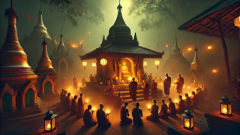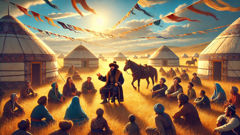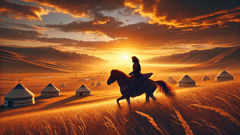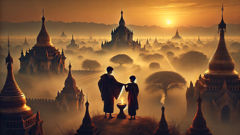Introduction
At the edge of a valley that smelled of teak sap and wet earth, the Pagoda of Silent Bells stood like an old promise. Vines braided the base of its stucco, and the gilded hti at its peak caught the last amber of day, scattering it into a slow rain of light over mossed steps. Villagers lit oil lamps each evening and set out bowls of jasmine; young novices chanted Pali under the shadow of frangipani trees; and elders traced the lines of ancient reliefs to remember names and deeds no longer spoken aloud. There, beyond the path of carts and the reach of market gossip, the people said that the Weza watched. Not godlike, nor wholly human, the Weza were semi-divine beings who had learned the arts that could bend wind and seal mouths against slander, who could speak with the root-deep spirits of fields and raise a protective circle of smoke to keep arrogance and greed from the doors of the pagoda. They were a secret effort of faith — an esoteric practice woven into everyday piety, a line of defense to safeguard the Dhamma when human resolve faltered. On a humid dusk when the monsoon threatened the river and a new novice named Khin arrived at the pagoda with little more than a shaved head and a stubborn fear in his chest, the elders would teach him parish rites, how to sweep leaves, how to fold the robe. They would not, at first, tell him about the Weza; those lessons were not for curious boys but for those with the patience to listen to the wind between the bells. Yet the story of the Weza is not merely a tale of power; it is a story of duty, restraint, and the fragile covenant between remembrance and the living. It begins with a vow taken in secret on a night when the bells chimed thirteen and the jungle breathed as if it were a sleeping animal with many lives.
The Novice and the Pledge
Khin came from a river village where boats kissed the banks like steady promises and rice paddies held small, precise seas of green. He had been sent to the Pagoda of Silent Bells by his mother, who believed a monk’s life would anchor whatever restlessness lived in his bones. At sixteen he was slight, with the hands of one who had worked nets and emptied ponds; his eyes were quick to notice the way shadows gathered under leaves and the precise bend of a well-rutted path. On his first night, the head monk received him with the slow, measured warmth of someone who knew how to balance mercy and discipline. Khin slept on a reed mat by the vihara, and at dawn he learned to pour water like an offering, how to hold a bowl with the humility of someone who remembers that everything is given. Yet as the days folded, Khin’s curiosity grew not from pride but from a raw desire to understand: why the elders sometimes left the pagoda after midnight and returned with pockets of earth and the smell of camphor, or why they would whisper to the banyan roots and leave offerings of salt and rice in secret hollows. His questions brushed against an older silence. The head monk, U Ba, would answer with proverbs and small jokes, but when asked about the Weza he only said, "The Weza are like the path of the wind. You hear it passing if you are still enough. To know more you must be still for a long time." The villagers had older stories that framed the Weza in both tenderness and caution. Some remembered a Weza who had saved a harvest by coaxing rain-swollen clouds with a chant that was half-song, half-instruction; others told of jealous landlords who had tried to seize a shrine and found their men turned away by an invisible wall, tools slipping like fish from their hands. Perhaps the most persistent memory was the tale of the three vows. It said that those who become Weza must first offer a vow to protect the Dhamma, then learn to hold silence when cruelty demands speech, and finally to surrender their claim to names and reward. The story, like the guardians themselves, blurred the line between miracle and moral test. One evening as the monsoon threatened, a messenger arrived breathless: a nearby village, the monks said, had been stung by rumor and greed; strangers had come offering to buy the shrine land for a port, promising coin and new roads. The head monk convened the elders beneath the open-air sala, and Khin, because he had asked more than his share of questions, was allowed to listen from the shadowed corner. The elders spoke of paperwork and the necessity of law, but their faces carried an exhaustion not from counting coins but from counting the cost of forgetting. Finally U Ba rose and spoke of the Weza with a steadiness that made even the wind outside seem to hold its breath. "We were entrusted," he said, "not because we are stronger, but because we remember. The Weza remember what is owed to the quiet ones who built these places. They will not fail while we keep our vows." That night, Khin followed the faint trail of lantern light past the frangipani and into the dry grove behind the pagoda. He did not mean to find the Weza; he simply could not sleep. The grove was a private theater of starlight and the muffled orchestra of insects. There, near a stone carved with the likeness of a meditating figure, the air seemed to slow. A presence settled without announcing itself — like breath drawn carefully not to disturb a sleeping child. Khin crouched behind a pandanus and watched a figure move beneath the moon: neither wholly shadow nor wholly human, it wore a robe that seemed to have been woven from dusk itself. Its face was unlined yet ancient; eyes that reflected no light looked out like pools of calm. The being folded a silver bowl and poured water, the stream forming patterns that lingered longer than water should. Khin’s curiosity caught flame with the foolish heat of youth. He stepped forward. The figure turned and, to Khin’s surprise, smiled as if the boy had merely arrived late for a familiar meal. "You are restless," the Weza said in a voice that rustled like fronds. "Restlessness is not always a fault. It can be a temple." For the first time Khin encountered a kindness that liberated shame. The Weza made no mystical proclamation. Instead it spoke of small, steady things: how a vow is kept not in thunder but in the consistent clearing of leaves, in the gentle refusal of easy temptations, in returning lost things to the poor man who forgets what is his. It taught him a chant that was not powerful like a storm but patient like a river. "We guard what we love," the Weza told him. "But to guard is not to conquer. It is to hold a space where the Dhamma can grow untroubled by crude hands." Khin slept that night with a new measure in his chest: devotion laced with the recognition that protection required something deeper than fear. Days became practice. Under the Weza’s guidance Khin learned to listen for the small rhythms of the pagoda — the shift of beetles beneath incense ash, the soft stumble of a fox in the outer compound, the precise cadence of the bell when a child bowed with unpracticed sincerity. He learned to braid cord with the same patient attention monks used when binding sutras. The villagers noticed a change in him: his hands steadier, his gaze softer, his questions metamorphosed into careful, necessary acts. The true test, however, was yet to come. Rumors, like seeds, take root in unlikely soil. The strangers who promised roads and coin returned with a letter of claim signed by men with polished words and greed that smelled faintly of lacquer and smoke. They arrived with blueprints and an official air that rustled like paper wings. The leaders demanded the land, citing development that would bring trade and prosperity. The villagers, who lived simply and loved the narrow arc of their lives, felt the pull of temptation and fear. U Ba called a meeting and, in the hush of the sala, he asked the villagers to remember why the pagoda had been built: not for gold or fame, but for shelter and for a place where stories might be taught to children who would not otherwise hear them. He then asked if anyone would take the third vow: to stand between the pagoda and those who would unmake it. No one moved. Men shook their heads because promises came with coin, and coin was the language of hungry mouths and rotting roofs. At the very moment when human courage seemed brittle as dried reed, the Weza came. It did not appear as a congregation of spirits but as a neat, unassuming presence. It walked among the crowd and laid a hand on a stranger's shoulder. Where it touched, anger diminished. Where it stared, greed found its edge dulled. Only those whose intentions had been long and kind could still see the Weza plainly; others perceived a mist, a ripple like heat above a dried road. When the men with blueprints tried to blow open the gates with legal threats and bribes, the weather itself seemed to tighten: an unexpected squall rose from the valley, rain that turned promises into soaked ink and smudged signatures. Their maps swelled and unraveled in the wind. The men left, muttering of bad luck and cursed weather, and the villagers, who had been readying themselves to bargain away memory, understood that defense came in forms they had not imagined. The cost had not been violence but a demonstration that a covenant existed between people and the land that sustains them. Khin watched all of it and learned that the Weza’s protection was not merely about repelling outsiders; it was about changing the hearts of those within, restoring a sense of proportion and care. The Weza taught him that sometimes protection means refusing a quick fix, sometimes it means keeping watch through nights of doubt, and sometimes it demands that those who guard relinquish the right to be thanked. When the storm cleared and the bells began again, Khin knelt by the water basin and turned his face towards the rising sun. He felt something steady and old take up residence inside him — an awareness that his life, however small, was now braided into the living pattern of the pagoda and its unseen guardians.

Ritual, Reckoning, and Remembrance
Years passed with the slow patience of seasons and the human heart folded into them. Khin advanced from novice to samanera and then to a young monk whose face bore the calm weather of someone who had learned to sit with discomfort. The village grew in small ways — a new well here, a child born acrobatic with laughter there — and the pagoda remained a constant pivot around which everyday life turned. The Weza moved like a quiet current beneath those days, intervening when greed or ignorance threatened to tear the fabric of communal memory. Yet the world beyond the valley widened. Traders with flashing belts and new languages; an official with a ledger and persuasive phrases; a religious teacher from a distant monastery who argued for a new line of practices that smoothed old complexities into marketable simplicity. The pagoda's elders tolerated novelty when it sharpened devotion, but when the new teacher suggested selling small relics to raise funds and replacing certain ceremonies with simplified recitations, an undercurrent of worry passed through the community. The elders convened again under broad palms. "Progress," one said carefully, "can be a gentle opponent. It persuades us to trade slowness for convenience. Who then remembers the small rites that hold a place true?" There was truth in the new teacher's words: some ceremonies had become rote, and upkeep cost effort the village could scarce afford. But the elders also understood that ceremonies were not mere performance; they were knot-holders for memory, and untie a knot and the story it keeps can wander off, like a child who never returns from the river. One night the pagoda's bell did not ring at the expected hour. A shadow moved like a hesitation across the sala: someone had broken into the small reliquary room, not to steal relics, but to remove the ribbons, the tied offerings, the little scraps of cloth that villagers placed on the shrine as promises and remembrances. When the theft became known, anger swelled like a tide. The new teacher argued for justice of a modern kind — surveillance, reward, trade-off. U Ba, older now but still steady, suggested something else. He asked for a slow tribunal: that those who had been wronged first be heard, that the community gather to retie their vows around the shrine, and that they invite the Weza to observe whether the theft had been committed out of desperation or profit. If the theft came from want, then reparation should be mercy; if from greed, then reparation should be restitution. The elders worked the days into preparations for the ritual. They cleaned the reliquary, invited callers to retell the old stories by the oil lamps, and asked Khin — because he had once been restless and had learned to listen — to stand with them. The evening they performed the rite, the pagoda yard brimmed with low lights and chanting. People placed bowls of milk and tamarind, tied cloth as if tying their breath to a memory, and sang an invocation that was less about asking and more about remembering. It was the kind of remembering that stitches a community’s seam. While the ritual hummed, the Weza moved through the crowd with the surety of someone reading a book they had lived through. It paused where a mother had tied a piece of blue cloth and touched the knot like a baker touching dough, testing if it would hold. Then, at the fringe of the ceremony, the Weza found what it sought: a boy not older than twelve, hiding beneath a banana leaf, his hands raw from handling ropes and his eyes black with hunger and shame. He had taken the cloths and sold them to a man at the edge of the market who brought tobacco and small coins. The boy's family had recently lost a father to fever; his mother could not feed the younger siblings. The Weza could have turned him away or unsettled his conscience with sudden revelation. Instead it sat near him and placed a palm lightly on his head. It whispered a sequence of small, careful practices — not grand absolutions but tasks that returned dignity: menders’ tasks, save-and-share chores, a pledge to return each item and to plant a pandanus for each cloth taken. The Weza stood as an intermediary between compassion and justice, refusing both to absolve nothingness and to punish without redemption. That night, the market man who bought the goods was found brooding with a sack of cloths and the metal coin he had hoped would make him laugh forever. He returned the cloths but kept his pride. The boy's hands learned to stitch again, this time under the patient gaze of elders who taught that work itself can be a form of prayer. The Weza’s lesson was not merely merciful; it was practical. It taught procedures that prevented future thefts — community-led storage, rotating watch duties, and an exchange program that allowed those in dire need to borrow the use of cloths for ceremonies and return them after the rite. Gradually a culture of mutual custody emerged: everyone was responsible to hold the memory of others. The new teacher, witnessing the humility and practical wisdom of the elders and the Weza’s subtle corrections, softened his proposals and learned that a faith’s preservation depended as much on networks of care as it did on simplified forms and new money. Not every confrontation ended quietly. Once, when a wealthy merchant sought to place a lacquered statue in the main shrine bearing his own likeness and name, claiming that fame would draw pilgrims and revenue, the reaction was bracing. Many villagers, fearing more change, opposed him. The merchant sued, and the case threaded through days of tense talk and legal bluster. In the courtroom of the district the merchant's rhetoric felt like a flood: monuments of name erased the quiet reciprocity the elders protected. When the merchant tried to enter the shrine one dawn with a document and a sculptor, the sky darkened as if in anger. The sculptor, his hands full of lacquer and design, felt his tools slip and break; the document ink smeared and the signatures smeared like fingerprints across rain-soaked cloth. The merchant’s vanity dwindled under the collective glance of a community that would not be bought. He left with threats that dissolved into complaints, then into anecdotes. In time the story of his attempt entered the web of village memory, a cautionary tale about the folly of substituting names for service. Through it all, the Weza never demanded worship. It asked only for attention to what mattered: the humblest rites, the stories of those who tilled the fields, the cautious teaching of children to care, the patient work of returning lost items. It taught Khin and the elders that guardianship is not an edict but a craft: the weaving of agreements, the steady listening to the heartbeat of a place, and the willingness to be invisible when being unseen best serves. Khin matured into a figure of quiet authority — not because he wielded the Weza’s power but because he had learned to apply the same long, patient craft the spirit practiced. When a severe drought later struck the valley, it was not only prayers but the Weza's careful rituals that helped. The Weza taught the community to reconfigure water channels, to release stored run-off into the soil where it could revive roots, and to perform a night-long chant that asked the sky to remember the covenant between land and people. The drought eased not by miracle alone but by a community that had long practiced mutual care. As the valley greened, songs were written about small things: the monk who mended a child’s sandals, the woman who baked rice cakes and offered them to strangers, the boy who learned to return a borrowed cloth. The Weza, true to its name as a guardian, continued to stand where it had always stood — at the margin between memory and neglect, at the quiet threshold where the Dhamma is either protected or allowed to erode. Its presence was a living metaphor for humility: that true protection binds people to one another, teaches restraint where greed threatens, and transforms law into living custom. Khin, now older and with a forehead scar from a fever that had nearly taken him, felt the old restlessness only when he saw complacency settle into those who should have been vigilant. He would walk the pagoda steps at dusk and find the Weza waiting like a patient friend, and their silent communication required no ceremony. Once, when Khin considered leaving to teach in a distant monastery, the Weza asked him in a voice like some gentle bell whether he would carry the methods of care with him. "Guard where you go," it said. "If you do, the Weza will follow in the ways that matter — not as spectacle but as habit." That counsel became his compass. He traveled when he must, bringing with him the small techniques and rituals that mended communities. Where he taught, people learned to keep watch for one another, to file promises into small, manageable acts and to treat every vow as a living thing. The legend of the Weza spread not because it was flamboyant but because it worked. Communities that adopted those quiet measures found they needed fewer tribunals, fewer harsh punishments. They learned to listen to the land and to each other. The Weza, wherever the Dhamma found faithful hands, was said to linger like a margin note in a beloved book, present when memory was read aloud and absent when indifference reigned. In the end, the legend tells us, guardianship is not the monopoly of the heroic or the spectacular. The Weza’s greatest art was the art of small refusal: refusing to allow greed to replace kindness, refusing to let convenience erode ritual, refusing to let memory drift. Its esoteric practices were not mere displays of power but tools for sustaining communities: chants that taught water to move more gently, knots that resisted decay, silences that allowed people to hear one another. These were the things that made the Dhamma not an idea to be quoted but a life to be lived.

Conclusion
The Legend of the Weza endures not because it offers a single miraculous rescue but because it frames a way of living that resists easy forgetting. In the pagodas and village halls across Myanmar, people still tell the story of guardian spirits who practice esoteric arts to protect the Dhamma, and each telling nudges a community toward small acts of courage and care. The Weza teach that protection requires patience: mending what is broken, restoring what was stolen not with vengeance but with structured mercy, and binding promises to action rather than to abstract words. The tale is a reminder that faith must be defended by hands that sweep and stitch as much as by hearts that pray; that rituals are not relics but tools to keep a memory whole; and that true guardianship often means stepping back so that a community can assume its responsibility. Khin, now remembered as both monk and teacher, carried those practices into the wider world, teaching that the ethics of guardianship are practical, communal, and humble. If you stand at the edge of a pagoda at dusk and the air seems to settle differently, listen closely: you may hear a faint pattern of steps and a chant that is less a spell than a steady calling. That is the Weza’s work: not to dominate, but to make room for the Dhamma to breathe, to survive, and to teach, for as long as people choose to remember and to act.


















